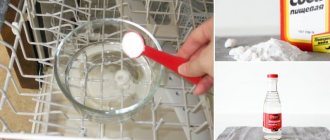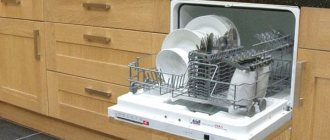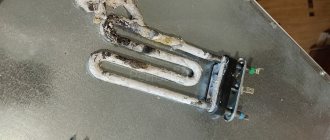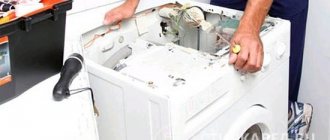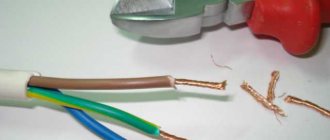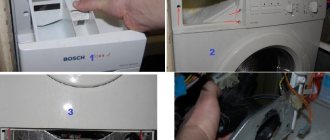How to tell if your dishwasher is on its last legs.
When it comes to kitchen appliances, many people underestimate the dishwasher. Like, why is it needed? I can wash the dishes myself. Here's what the facts say:
- Washing dishes by hand is less effective and leaves more bacteria on the dishes.
- A dishwasher can save you up to 10 days a year of washing dishes by hand.
- An energy-efficient appliance reduces water consumption and therefore utility bills.
So you should definitely think about buying such an assistant for your kitchen. Especially during a pandemic, when each of us wants to be sure that he is using perfectly clean plates and cutlery. And if you already have a dishwasher, you need to carefully monitor its condition.
Appliance experts are unanimous in saying that many dishwashers—perhaps even the one in your kitchen right now—are in desperate need of replacement.
Today we will tell you about 12 signs that will indicate that your dishwasher is already on the verge.
What do we know about dishwashers?
A dishwasher is an electromechanical device designed to make your work in the kitchen easier. Designed in the mid-19th century, the machine had a manual drive. Gradually evolving, the models acquired their present appearance by the middle of the twentieth century, and in the 70s they became so widespread in the USA and Western Europe that more than 90% of foreign housewives cannot imagine a kitchen without a dishwasher, as well as without a refrigerator or stove. In the minds of the Russian consumer, such a low popularity of this unit is explained by the bearded myths about the miracle machine.
The water in the machine can be heated much hotter than when washing by hand, up to approximately 50–60 degrees. You can use other detergents that are harmful to the skin of your hands. According to numerous studies, plates, cups and forks washed in a dishwasher are 1,000 times cleaner than washing similar dishes by hand. These are completely smooth cutlery and bowls, and if we take, for example, an old grandmother's vase with intricate embossing, then it is unlikely that you will shine it as easily and quickly as in the dishwasher.
Not true! If you have a washing machine at home and you didn’t skimp on buying it, then a dishwasher is similar in cost, which is more expensive than a microwave, but much cheaper than a refrigerator or a good plasma. The price, depending on the set of options, ranges from 12,000 to 65,000 rubles. Having bought a dishwasher, you will no longer imagine a day without this unit.
This statement will be true if you run a full cycle for each dirty cup individually. When you turn it on once every day, you will be surprised that the amount of water consumed is exactly the same as what you would use when washing it by hand. Well, no more electricity is wasted than when turning on an electric kettle twice.
Think about how you would like to spend your free time? If time is valuable to you, then a dishwasher is a must. Today, this device is widely represented on the Russian market by well-known brands of household appliances, such as Bosch, Electrolux, Whirpool, Siemenes, Candy, Beko, Hansa, etc. For any request and budget.
Before starting work, just like a washing machine, the dishwasher must be connected to water supply, sewerage and electricity. If you have experience installing such equipment, then this task will not be difficult. However, for people who have no idea about adapters, filters and other plumbing intricacies, it is better to seek help from specialists in order to eliminate the possible consequences of leaks “on the heads” of the neighbors below.
The dishwasher is connected to both cold and hot water supply or both at once. In both cases there are pros and cons. Cold water does not contain particles of scale and scale, which will increase the life of your dishwasher. However, it will take additional time and some energy costs to heat it to the desired temperature. Connecting directly to a hot water supply will reduce your costs, but we all know very well that hot water is turned off in the summer (in some regions there is no hot water for a long time). During this time you will have to do without a kitchen assistant. This can be avoided by purchasing a special mixer, with which the machine can operate from cold and hot water, regardless of the plans of the water utility. An additional device will cost you approximately 6,000 rubles.
The door does not latch
JOHNER IMAGES / GETTY IMAGES
According to repair expert, CEO and founder of Dwelling Nick Ornitz, if your dishwasher door won't latch, it's a wonder the appliance even started . The good news is that the latch can be replaced . If this does not help, most likely the entire machine will have to be replaced.
“If it’s not a simple matter of replacing the latch,” Ornitz says, “the door is likely warped .” This usually results from prolonged exposure to water. To avoid the situation where you load your dishwasher only to find it won't work because of the door - look out for earlier warning signs of leaks and clogs.
How to properly care for your dishwasher?
Our homes contain a large amount of technology that does all the hard work for us. Washing machines and dryers provide comprehensive clothing care, vacuum cleaners help keep things clean, and dishwashers eliminate the need to wash dishes by hand every day. We can devote the freed time to relaxation, hobbies or communication with loved ones. If a device fails, it will cause a lot of inconvenience to its owner. To delay the occurrence of breakdowns as much as possible and extend the life of equipment, you need to take care of it, and dishwashers are no exception. What operating rules should be followed?
You take out cold dishes
SALLY ANSCOMBE/GETTY IMAGES
If hand washing depends on how well you remove stains, dishwashers rely on a spray of hot water for everything . It's unlikely that your hands will be able to withstand the temperature required to properly sanitize utensils as recommended by the FDA, which is just one reason why you shouldn't wash utensils by hand.
Immediately after the dishwasher completes its cycle, your dishes should be hot to the touch . If it doesn't, "there's likely a problem with the heating element inside the machine ," says Rob Shaw, home appliance expert at ProTip. – The heating element is expensive to replace. So if you end up with cold dishes after cleaning, you may need to consider replacing your dishwasher.”
How much does PMM spend?
Full-size machines consume an average of 9-14 liters of water. Narrow devices, as well as premium class machines, require no more than 7 liters. If the device has a half-load operation, water consumption is reduced by 20-30%, which leads to additional savings.
When washing dishes manually, on average, 20 to 100 liters are required . There are clear benefits from using dishwashers. Read more here.
Dishes remain dirty
LA BICICLETA VERMELLA / GETTY IMAGES
You might think that if your dishes come out of the dishwasher with food residue on them, they're done. However, this is not always the case. "If your dishwasher isn't doing its job properly, the first thing you should do is check to see if there are any food particles in the filter , which is located in a cylinder at the bottom of the unit," advises Albert Lee, founder of Home Living Lab. .
"If you don't find anything suspicious, your next step is to thoroughly clean the dishwasher," says Audrey Monell, president of Forrest Anderson Plumbing and Air Conditioning in Glendale, Arizona. You need to remove the filter and wash it with hot, soapy water. And don’t forget to clean the spray nozzle, which could also be clogged.
If the dishes are still dirty, it could be due to hard water or dried-out food . But if you have already tried everything, but to no avail, most likely the problem is in the machine itself. In this (hopeless) case, it is recommended to replace it.
Types of dishwashers
Let's start with the fact that all dishwashers are divided into built-in and free-standing. The latter, in turn, can be large floor-standing or compact tabletop. In essence, full-size built-in and free-standing models differ little, but externally there is a difference. Built-in machines are difficult to distinguish from ordinary cabinets: its door is decorated with a decorative panel, in color and shape no different from other elements of the kitchen set. In general, a kitchen with built-in appliances looks more harmonious than even a very well furnished one, but with free-standing equipment.
Tabletop models of dishwashers are relevant for a small family of one or two people. Despite the name, they are usually installed not on tables, but on kitchen cabinets, for example, between the stove and the sink. Sometimes the kit includes a frame for installation in wall cabinets.
A tabletop “baby” usually holds from four to six sets of dishes, the washing cycle lasts about half an hour, and the water consumption is 13-14 liters. Like a large dishwasher, in addition to the main program, this compact model has several additional ones, including an economical program for lightly soiled dishes, pre-soaking for heavily soiled dishes, and a glass washing program at 30 °C. With its small size and capacity, a countertop dishwasher does its job well.
However, in a family of three or four or more people who prefer home-cooked meals to going to a cafe or restaurant, such a model would have to be turned on after every meal. For a more rational use of electricity, water and detergents, it is more convenient to purchase a floor-standing machine for 6-8 or (if the family is very large) for 9-14 sets of dishes. It is enough to turn on such machines once a day, ensuring that they are fully loaded beforehand.
There is a puddle at the bottom of the car
RAGNAR SCHMUCK/GETTY IMAGES
According to Monell, if you open the dishwasher door after a cycle has finished and find water at the bottom, that's a major sign that your mate needs replacing . This means that the dishwasher is not draining water as it should.
But before you buy a new one, check to see if the drain is clogged . If you see a clog, try clearing it yourself using a wire hanger bent into a "U" shape . Also, if you have a food waste disposer, check the disposal drain line to make sure this is not the root of the problem.
"If you don't find any physical obstruction, it's possible that the drain itself is faulty ," Ornitz says.
In this case, the only way out is to replace the machine.
Installation and first launch
The dishwasher must be connected to electricity, cold water and sewerage. Installation of equipment, especially built-in ones, must be done professionally. If you do not have experience or the appropriate tools, it is better to use the services of qualified specialists. Upon completion of installation, you need to test the dishwasher in idle mode, without dishes. Using water, the system is flushed from small debris and factory lubricant residues. During a test wash, the user will be able to understand whether the device is working correctly. It is necessary to pay attention to whether the water is heated and drained, and whether errors were made during installation. The latter can manifest themselves in different ways: failures at various stages, leaks, strange sounds.
If everything is in order, you can perform the first wash with a full load. It is also recommended to monitor this entire cycle in case of emergency situations. When the automatic program has completed, you should wait 10-15 minutes to allow the wash chamber and kitchen utensils to cool down. Then we take out the dishes and evaluate the quality of stain removal. At this stage, the effectiveness and correctness of the choice of detergents is assessed. If there are food residues on the items, the mode may have been selected incorrectly. For example, a delicate wash will not cope with old, dried-on stains.
The car is leaking
IMAGE SOURCE / GETTY IMAGES
If you see a puddle of water on the floor in front of your dishwasher, Monell notes, chances are you've already noticed a puddle at the bottom of the dishwasher . Water on the floor is an even better sign that it's time to replace your dishwasher. Turn off the water supply, wipe the floor and dishwasher dry, and wait for the plumber.
There is rust on the outside of the car
ABLOKHIN / GETTY IMAGES
According to Shaw, rust is never a good sign, no matter whether it's inside or outside the car. "Any time you see rust in your dishwasher or on its surface, it's a sign of a water leak," explains the expert. This may require either expensive plumbing repairs or complete replacement of the unit.
Rust has formed inside the car
LUMINOLA/GETTY IMAGES
Never ignore rust that has appeared inside your dishwasher! Firstly, this means that there is rust on “clean” dishes . Second, it's a sign that the inside of your dishwasher is worn out or broken into pieces , causing the underlying metal to begin to rust.
One way to quickly diagnose the problem is to run the dishwasher dry and add a spoonful of citric acid to the detergent container . If this doesn't get rid of the rust, call a plumber.
Have you noticed any cracks?
ELENA PEJCHINOVA / GETTY IMAGES
Of course, if you notice a clear crack inside the dishwasher, rust and leaks (even if they haven't appeared yet) are clearly just around the corner .
Scratches and cracks can occur as a result of normal wear and tear or because you put an item that is not dishwasher safe in the dishwasher . If you notice a crack, turn off the water supply and call a plumber immediately to prevent a flood in your home or apartment.
Dishwasher. 5 steps for a better choice
It is not difficult to find, easy to choose and impossible to deny yourself the pleasure of using it. An indispensable assistant in everyday routine to protect your free time and well-groomed hands - we learn how to choose a dishwasher.
If you are thinking about purchasing it for the first time, there is a 100% chance that you still have doubts. Without going into technical details, we’ll go through the pros and cons of this unit and help you make a final decision.
Dishwasher makes strange noises
WAVEBREAKMEDIA LTD / GETTY IMAGES
Even the quietest dishwashers make noise when they enter the rinse cycle . But if it seems unusual to you, turn off the device and find the source of the sound .
Perhaps it comes from the impact of utensils against each other. Or the culprit is some part of the device. If you do not find obvious reasons, you can assume that the problem is in the engine . In this case, repairing or replacing it may cost you more than buying a new car.
Machine is not Energy Star certified
LA BICICLETA VERMELLA / GETTY IMAGES
“If your dishwasher is not Energy Star certified, you may want to consider replacing it right away. It doesn't matter whether you have problems or not,” says Darryl Webber, Ph.D., chairman of the Department of Mechanical and Aerospace Engineering at Trine University in Angola, Indiana.
Dishwashers began being labeled in June 1996 to designate appliances that are at least 12% more efficient than non-certified models and more efficient than models that meet a minimum “energy efficiency” standard.
Washing dishes in a new Energy Star-certified dishwasher instead of washing by hand will save you an average of 14,000 liters of water over its lifetime , and therefore reduce your utility costs.
How long does it take for a dishwasher to clean?
Washing dishes by hand is a troublesome task: it takes a lot of time, and if a lot of it accumulates, then the water consumption will be significant. Therefore, many people strive to install a dishwasher in their kitchen.
But how long does the machine take to wash and is it really more economical? From the article you will find out how long the dishwasher runs with different modes and installation of individual programs.
